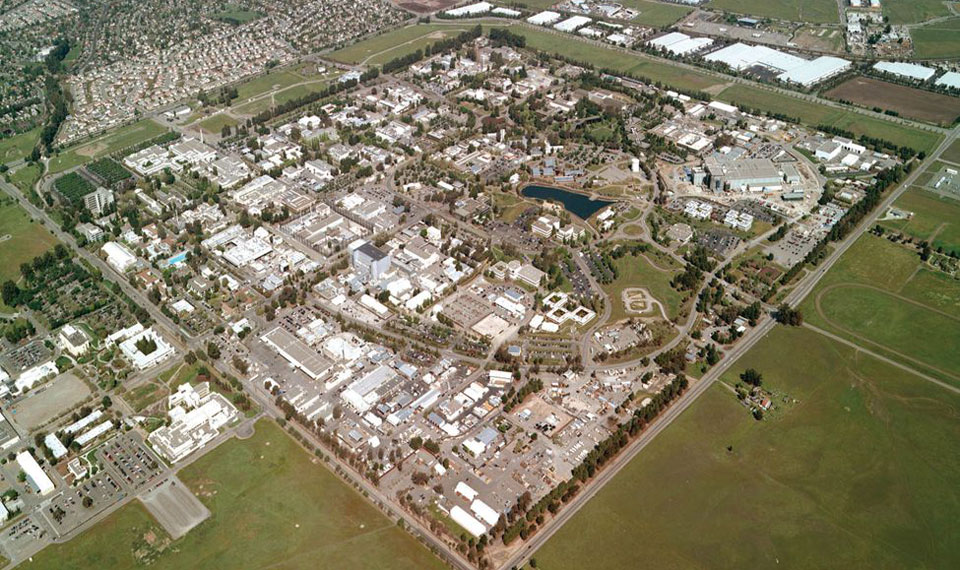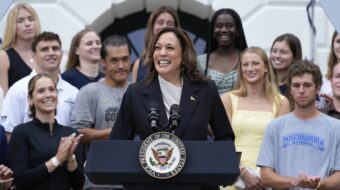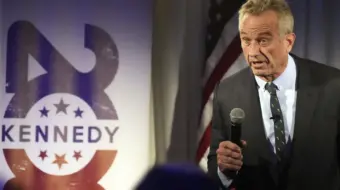
LIVERMORE, Calif.–Nuclear disarmament activists in the San Francisco Bay Area gathered virtually on April 2 to honor a nearly four-decades-long tradition, the Good Friday Swords into Plowshares Worship and Witness at Lawrence Livermore National Laboratory, one of the two sites where every nuclear warhead and bomb in the U.S. arsenal is designed.
This year the agenda focused on two very different developments – on one hand, the nuclear weapons being developed at Livermore Lab and their catastrophic potential, and on the other, new legislation now before Congress, and the new Treaty on the Prohibition of Nuclear Weapons, often called “the Ban Treaty,” so far signed by 86 countries and ratified by 54, none of them possessing nuclear weapons.
Setting the stage was Marylia Kelley, Executive Director of Tri-Valley Communities Against a Radioactive Environment (TriValleyCAREs), who addressed the gathering from the West Gate of the lab, as scientists and support workers entered to start the morning’s work.
Livermore Lab uses over 85% of the funding it gets from the U.S. Department of Energy for nuclear weapons, Kelley said. By comparison, less than 2% of the funding is for science, and less than 1% goes to research into energy efficiency and renewable energy.
“Therefore,” she said, “when I speak to you this morning about what goes on inside this classified fence line, it’s fitting to begin with Livermore Lab’s central role in driving a new and dangerous global arms race.”
Heading the list is a new warhead, the W80-4, intended to enable pilots to launch a precisely guided, radar-evading nuclear weapon thousands of miles away from its target. “By any measure, she said, “Livermore’s new warhead for this long-range standoff capability is a first-strike offensive weapon.”
Livermore is also developing the W87-1 warhead, which Kelley said is “the first fully-new warhead design since the announced end of the Cold War 30 years ago,” and a new submarine-launched warhead, the W93.
Adding to the bad news, over the years TriValley CAREs has documented the release of more than 1 million curies of radiation into the surrounding air, and soil and groundwater at the Lab and its Site 300 high explosive testing range are so polluted they are on the Environmental Protection Agency’s list of Superfund sites.
On the positive side, Kelley said, Senator Ed Markey, D-Mass. and Rep. Ro Khanna, D-Calif., have just introduced into Congress the Invest in Cures Before Missiles, or ICBM Act. The measure would halt further development of the Pentagon’s new ground-based strategic deterrent intercontinental ballistic missile and the W87-1 warhead it would carry, redirecting funding to the National Institute of Allergy and Infectious Diseases to develop a universal coronavirus vaccine and other research on emerging diseases.
Kelley urged all participants to press their members of Congress to support the new legislation and to use the “fresh opportunities before us, to change the direction of U.S. nuclear policy and move instead to the abolition of nuclear weapons … Together, we can do this, we can make this paradigm shift.”
Jackie Cabasso, executive director of Western States Legal Foundation, told of being at United Nations’ headquarters in New York City last July to witness the adoption of the Treaty on the Prohibition of Nuclear Weapons by a majority of the world’s countries.
“Watching countries vote, by 122-1, to prohibit the possession, development, testing, use, and threat of use of nuclear weapons was a thrilling moment,” she said, “but it was bittersweet.”
While the Ban Treaty represents the total repudiation of nuclear weapons by most of the countries that don’t possess them, Cabasso said, the U.S., the eight other nuclear states, and others under the U.S. nuclear umbrella boycotted the talks, and the U.S., United Kingdom, and France declared after the vote that they would not sign, ratify or ever become party to the treaty.
In the decades since World War II, she said, U.S. national security policy has focused consistently on deterrence – the threatened use of nuclear weapons – even as geopolitical conditions and presidential styles, have changed.
“Today, more than 13,000 nuclear weapons, most an order of magnitude more powerful than the U.S. atomic bombs that destroyed Hiroshima and Nagasaki, 91% of them held by the United States and Russia, continue to pose an intolerable danger to humanity, and the dangers of wars among nuclear-armed states are growing.”
At the same time, ever since the very first United Nations General Assembly resolution in 1946 established a commission of the Security Council “to assure the elimination from national armaments of atomic weapons and all other major weapons adaptable to mass destruction,” nuclear weapons have repeatedly been declared illegal in international law. And in fact, the original nuclear-armed states – the U.S., United Kingdom, France, Russia, and China – pledged in the 1970 Nuclear Nonproliferation Treaty “to pursue negotiations in good faith” to end the nuclear arms race at an early date and achieve nuclear disarmament.
Western States Legal Foundation has been engaged in the work leading to the 2016 UN General Assembly resolution that called for negotiation of the Ban Treaty, Cabasso said. “But our work is far from done.” With multiple national and global crises, including nuclear weapons, climate change, systemic racism, the growing wealth gap, and rising national authoritarianism sharing the same foundational causes, “we are unlikely to prevail on any of them as single issues.”
Cabasso called on all participants in the Good Friday action to become involved in the Poor People’s Campaign, which she said is taking up Dr. Martin Luther King’s unfinished work and weaving the interlocking injustices of systemic racism, systemic poverty, environmental devastation, militarism, and the war economy into one moral fusion campaign, and calling in its Moral Budget for U.S. military spending to be cut in half.
In a moving homily that paid tribute to the victims and survivors of the Hiroshima and Nagasaki bombings, the Rev. Michael Yoshii of Alameda’s Buena Vista United Methodist Church, observed, “For those of the Christian faith, we know that Jesus came to empower the marginalized and the powerless, and to challenge those who wielded the power of weapons and of empire. It is only fitting that those nations that have no nuclear weapons are the ones to call upon those wielding the power and threat of weapons, to put those weapons away so that we can live in peace in this world.”
Coordinating the event on behalf of initiating organizations Ecumenical Peace Institute/Clergy & Laity Concerned and Livermore Conversion Project were Carolyn Scarr and Carl Anderson. They were joined by more than two dozen cosponsors.
Among many helping to lead the observance were Farha Andrabi Navaid, Mountain View/Palo Alto Musalla; musician Betsy Rose; Rev. Max Lynn, St. John’s Presbyterian Church/Berkeley; liturgical dancer Carla De Sola; social justice and indigenous activist Patricia St. Onge and Janet Cordes Gibson, EPI/CALC.












Comments